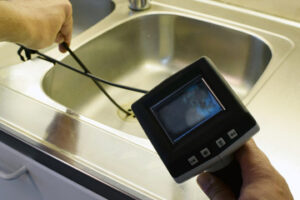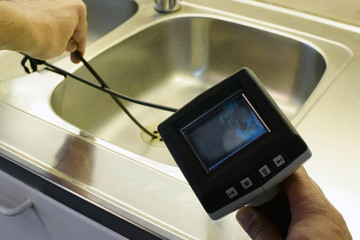Home inspectors often recommend that homeowners get Sewer Scope Inspection before buying their new house. These inspections help uncover potential problems and save homeowners thousands of dollars in costly repairs.
A certified professional will insert a camera with lights into the access point and down the lateral pipe to check for damage, blockages, or other issues. The inspector will record the results and write a report.
Sewer line issues often occur without warning, and they are costly to repair. Home inspectors are able to find out about problems with a sewer line by conducting a sewer scope inspection, but this isn’t usually included in a standard home inspection. Adding this service to your inspection list can expand your client base and provide you with a good return on your investment in equipment.
A sewer scope inspection involves inserting a small camera into the main waste line that runs from the house to the septic system or city sewage lines. The inspector will look for damage, signs of potential problems, and other factors that can cause expensive repairs or backups.
Inferior pipe materials: older homes may have clay pipes that are prone to cracking and failure. Newer homes generally use PVC pipes, which are less prone to damage. Your inspector can spot these issues and advise the homeowner about future maintenance.
Blocked drains: If multiple household drains are backing up, this could indicate a problem with the sewer line. The inspector can use the camera to identify the source of the issue and recommend the best course of action.
Minor belly areas: When a sewer line slopes down near the house, this is referred to as a “belly.” This can collect debris that interferes with flow and causes clogs or other problems. A minor belly can be caused by poor initial layout, ground shifting, or even tree roots. Your inspector will let you know if the problem is serious enough to warrant repair.
Leaky or partially blocked pipes: A damaged or cracked sewer line can result in water seepage into the yard and inside the home. Leaking sewage can wreak havoc on a property, and it’s important to identify and repair the problem as quickly as possible. A sewer scope inspection is the best way to do this.
Exposed Aggregate
Exposed aggregate is a decorative concrete finish where rocks, sand, pebbles, or other materials are added to the cement mix and then exposed in a pattern on sidewalks, driveways, or patios. The result is a unique and modern look for these surfaces while also offering the durability and strength of regular concrete. This type of concrete is popular for its beauty, but it can also add value to a home by decreasing maintenance costs and enhancing curb appeal.
Like any other type of plumbing, sewer lines can be damaged by water leaks, tree roots, and other factors. Damaged or blocked pipes will lead to a variety of issues for homeowners, including expensive repairs and possible health risks. A sewer scope inspection can help identify these problems early on and save homeowners time and money in the long run.
Sewer lines are made of a variety of materials, including PVC and ABS plastic. While they are more durable than metal pipes, these lines can still be damaged by root infiltration, ground shifting, and other factors. A regular inspection from pillar to post can spot these issues and address them before they become more serious.
Adding a sewer scope inspection to your list of services can make a big difference in the profitability of your business. While the initial investment in equipment may seem steep, the potential for increased revenue will quickly offset this cost.
Before starting the inspection, it is important to establish an access point for the camera and determine how to get through any obstacles. Your inspector will then check the area for leaks and put down drop cloths before beginning the process. They will push the camera through the line, pausing at any defects or blockages to record them in detail. Your inspector will then be able to discuss these findings with you, suggest next steps, and answer any questions.
Many potential buyers may not realize the importance of having a thorough sewer scope inspection before buying a home. However, there are several common signs that can indicate a problem with the sewage line, such as water backing up inside the home or crawlspace. By performing a simple inspection before purchasing a property, you can avoid costly repairs and stress down the road.
Cracks or leaks
Depending on the age of a home, its plumbing materials, and its location, the sewer line can have problems. The good news is that a professional can help you uncover any invasive tree roots, breaks, cracks, or other issues that could cost you thousands in repairs down the road. A sewer scope inspection uses a camera attached to a snake-like cable to examine the private, homeowner-owned pipeline that runs from a house to the public sewer line or septic tank. This allows homebuyers, sellers, and current homeowners to act quickly before more extensive damage or health problems occur.
A faulty sewer line can cause a host of problems, including leaks, sewage backups, and even structural damage to the home. A clogged or damaged line can also expose the property to rodents and other unwanted pests. Moisture from a busted line can lead to mold and mildew. A professional home inspector will be able to identify and report any serious issues with the property before you buy or sell it.
The most common causes of broken sewer lines include:
Root Intrusion
Fast-growing tree roots are notorious for wreaking havoc with lateral sewer pipes. They enter through the smallest of cracks and feed on the water and nutrients that run through the pipes. Once inside, the roots can push and break apart the pipes.
Other common issues with lateral sewer lines include:
Breaks or cracks
A homeowner’s aging clay or concrete sewer line is susceptible to cracks and breakage over time. When these lines break, they can cause sewage to back up into the home or yard, which can lead to expensive repairs. A faulty line can also be the source of a wet or soggy lawn, which is an indication that there are problems with the line beneath the surface.
A reputable home inspector will flush the sewer line with water before the inspection to lubricate the pipe and ensure that the camera does not catch on any debris in the line. The inspector will then establish an access point, check for leaks at that location, and place drop cloths to prevent the inspection area from becoming dirty or contaminated. Then, the inspector will press the camera into the main or lateral sewer line and carefully watch it to find any blockages or other issues. Once the inspection is complete, your home inspector will provide you with a detailed report and suggestions for next steps.
Tree Roots
Tree roots are a common problem for homeowners. They love the moisture and nutrients found in drain lines. Unfortunately, this is also what makes them dangerous to sewer lines, especially if the pipes are damaged or old.
The best thing to do is prevent tree roots from invading your home’s sewer line in the first place. You can do this by planting trees far away from your home’s drain lines and keeping them well trimmed. Inspecting the sewer lines regularly with a sewer scope is another great way to keep an eye on your line as well as locate and repair any issues that may be occurring.
One of the main things you should look for are signs that roots are infiltrating the line, such as slow drains and gurgling toilets. You can also get a more comprehensive inspection of your sewer line by having an inspector use a high-powered camera to see what is inside the pipes. This allows them to spot any cracks, blockages, or damage that you might not have been able to see from the surface.
If you do notice any of these signs, it is important to call a plumber right away to have the problem fixed before it gets worse. Plumbers have the tools and knowledge to effectively kill the roots and repair any damage that has occurred.
When the roots are invading your home’s drain lines, it is possible that they have caused a clog. This means that the sewage is not flowing properly through your pipes and into the system. When this happens, it can cause a lot of problems for your home, including backups and smelly drains.
Fortunately, most sewer clogs are preventable with regular maintenance. A sewer scope inspection can be done before you purchase a home, and it is recommended for any homeowner. It is an inexpensive way to keep tabs on your drain lines and make sure that they are functioning correctly. You can even get a professional to help you perform these preventative inspections by using a drain snake.

